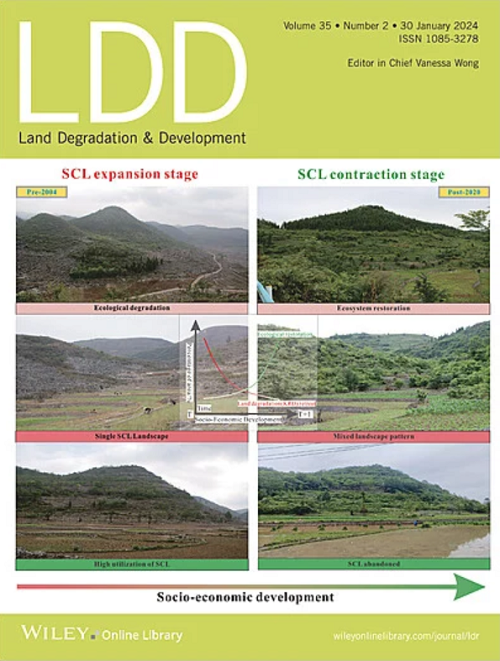在全球酸性土壤中应用生物炭在减少温室气体和提高产量方面的巨大潜力
IF 3.6
2区 农林科学
Q2 ENVIRONMENTAL SCIENCES
引用次数: 0
摘要
由于生物炭特性、初始酸性土壤特性以及实验和气候条件的变化,生物炭减少温室气体排放、全球变暖潜值(GWP)、温室气体强度(GHGI)的能力及其对产量的影响尚不清楚。本研究旨在通过对288份出版物的荟萃分析,结合随机森林回归结构模型和全球预测,确定生物炭在缓解酸性土壤GWP和GHGI的同时提高产量的潜力。结果表明,在土壤pH <; 7条件下,热解温度<; 550℃产生的生物炭通过减少CH4(- 16%)和N2O(- 13%),增加CO2(12%),典型地降低了GWP(- 11%)和GHGI(- 24%)。在热带气候(年平均温度:18°C - 32°C,年平均降水量:1000-3000毫米)中应用生物炭可有效提高产量31%。相对而言,影响生物炭潜力的最重要因素是初始土壤阳离子交换容量(对全球潜能值的影响为24%)、土壤有机质(对GHGI的影响为19%)和生物炭氮(对产量的影响为29%)。随机森林回归模型预测,在全球6.4%的酸性土壤中,生物炭提高了15%的最大产量(lnRR = 0.393 ~ 0.651),降低了6.4%的最大GWP (lnRR = - 0.911 ~ - 0.422)。然而,生物炭在高有机质(2%)酸性土壤增产效果最差,而在年平均气温较高(20.9°C)地区,生物炭会导致GWP增加(lnRR = 0.023-0.236)。在减少温室气体排放方面,生物炭在低总氮(1%)的酸性土壤中最有效。总体而言,该研究强调并预测了生物炭在不同地理区域酸性土壤中减缓全球升温潜能值和温室气体排放以及增加产量的潜力。本文章由计算机程序翻译,如有差异,请以英文原文为准。
Great Potential of Biochar Application in Reducing Greenhouse Gases While Increasing the Yield in Acidic Soil of Global Cropland
Biochar's ability to mitigate greenhouse gas emissions, global warming potential (GWP), greenhouse gas intensity (GHGI), and its impact on yield remain unclear due to the variation in biochar properties, initial acidic soil properties, and experimental and climatic conditions. This study aimed to determine the biochar potential in mitigating GWP and GHGI while simultaneously increasing yield in acidic soils through a meta-analysis of 288 publications combined with a random forest regression structure model and global predictions. The results showed that in soil pH < 7, biochar produced at pyrolysis temperature < 550°C typically decreased the GWP (−11%) and GHGI (−24%) by reducing CH4 (−16%), N2O (−13%), while increasing CO2 (12%). Biochar application in tropic climates (mean annual temperature: 18°C–32°C, mean annual precipitation: 1000–3000 mm) is highly effective in increasing yield by 31%. The relatively most important factor influencing biochar potential was initial soil cation exchange capacity (24%) for GWP, soil organic matter (19%) for GHGI, and biochar nitrogen (29%) for yield. The random forest regression model predicted that biochar increased maximum yield (effect size (lnRR) = 0.393–0.651) in 15% and decreased maximum GWP (lnRR = −0.911 to −0.422) in 6.4% of acidic soils globally. However, biochar was least effective in increasing yield in acidic soils with high organic matter (> 2%) and led to increased GWP (lnRR = 0.023–0.236) in areas with high mean annual temperatures (> 20.9°C). For GHGI reduction, biochar was most effective in acidic soils with low total nitrogen (< 1%). Overall, the study highlighted and predicted the biochar potential to mitigate GWP and GHGI and increase production in acidic soils of diversified geographical regions.
求助全文
通过发布文献求助,成功后即可免费获取论文全文。
去求助
来源期刊

Land Degradation & Development
农林科学-环境科学
CiteScore
7.70
自引率
8.50%
发文量
379
审稿时长
5.5 months
期刊介绍:
Land Degradation & Development is an international journal which seeks to promote rational study of the recognition, monitoring, control and rehabilitation of degradation in terrestrial environments. The journal focuses on:
- what land degradation is;
- what causes land degradation;
- the impacts of land degradation
- the scale of land degradation;
- the history, current status or future trends of land degradation;
- avoidance, mitigation and control of land degradation;
- remedial actions to rehabilitate or restore degraded land;
- sustainable land management.
 求助内容:
求助内容: 应助结果提醒方式:
应助结果提醒方式:


